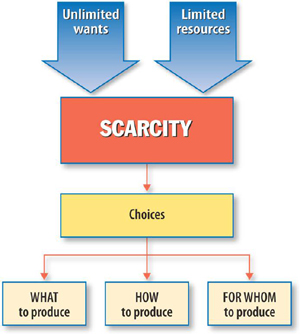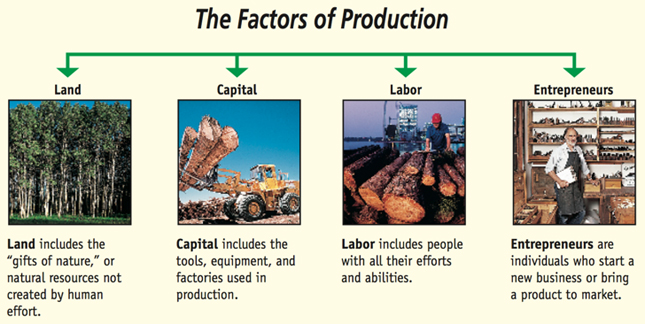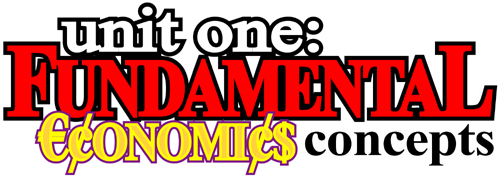The Fundamental Economic Problem
Societies do not have enough productive resources
to satisfy everyone’s wants and needs.
Have you ever noticed that very few people are satisfied
with the things they have? For example, someone without a home may want
a small one; someone else with a small home may want a larger one; someone
with a large home may want a mansion. Whether they are rich or poor, most
people seem to want more than they already have. In fact, if each of us
were to make a list of all the things we want, it would most likely include
more things than we could ever hope to obtain.
Scarcity
| The fundamental economic problem facing all societies
is that of scarcity. Scarcity is the condition that results
from society not having enough resources to produce all the things people
would like to have.
scarcity
fundamental economic problem of meeting people’s virtually
unlimited wants with scarce resources
As the image on the right shows, scarcity affects almost
every decision we make. This is where economics comes in. Economics
is the study of how people try to satisfy seemingly unlimited and competing
wants through the careful use of relatively scarce resources. |
|
 |
economics
social science dealing with how people satisfy seemingly
unlimited and competing wants with the careful use of scarce resources
Needs and Wants
Economists often talk about people’s needs and wants.
A need is a basic requirement for survival, such as food,
clothing, and shelter. A want is simply something we would
like to have but is not necessary for survival. Food, for example, is needed
for survival. Because many foods will satisfy the need for nourishment,
the range of things represented by the term want is much broader than that
represented by the term need.
need
basic requirement for survival, including food, clothing,
and shelter
want
something we would like to have but is not necessary
TINSTAAFL
Because resources are limited, everything we do has a
cost—even when it seems as if we are getting something “for free.” For
example, do you really get a free meal when you use a “buy one, get one
free” coupon? The business that gives it away still has to pay for the
resources that went into the meal, so it usually tries to recover these
costs by charging more for its other products. In the end, you may actually
be the one who pays for the “free” lunch!
Realistically, most things in life are not free, because
someone has to pay for producing them in the first place. Economists use
the term TINSTAAFL to describe this concept. In short, it
means There Is No Such Thing As A Free Lunch.
What is the difference between
a need and a want?
REVIEW & DO
NOW
Answer the following questions: |
| What is the fundamental economic problem?
What is scarcity?
What is economics? |
|
What is the difference between a need and a want?
Give an example of a need.
Give an example of a want.
What is TINSTAAFL? |
|
|
|
Three Basic Questions
Scarcity forces every society to answer the basic
questions of WHAT, HOW, and FOR WHOM to produce.
Because we live in a world of relatively scarce resources,
we have to make careful economic choices about the way we use these resources.
WHAT to Produce
The first question is WHAT to produce. For example, should
a society direct most of its resources to the production of military equipment
or to other items such as food, clothing, or housing? Suppose the decision
is to produce housing. Should the limited resources be used to build low-income,
middle-income, or upper-income housing? A society cannot have everything
its people want, so it must decide WHAT to produce.
HOW to Produce
A second question is HOW to produce. Should factory owners
use automated production methods that require more machines and fewer workers,
or should they use fewer machines and more workers? If a community has
many unemployed people, using more workers might be better. On the other
hand, in countries where machinery is widely available, automation can
often lower production costs. Lower costs make manufactured items less
expensive and, therefore, available to more people.
FOR WHOM to Produce
The third question is FOR WHOM to produce. After a society
decides WHAT and HOW to produce, it must decide who will receive the things
produced. If a society decides to produce housing, for example, should
it be the kind of housing that is wanted by low-income workers, middle-income
professional people, or the very rich? If there are not enough houses for
everyone, a society has to make a choice about who will receive the existing
supply.
These questions concerning WHAT, HOW, and FOR WHOM to
produce are never easy for any society to answer. Nevertheless, they must
be answered as long as there are not enough resources to satisfy people’s
seemingly unlimited wants and needs.
Why are societies faced with
the three basic questions of WHAT, HOW, and FOR WHOM??
REVIEW & DO
NOW
Answer the following questions: |
| Can a society produce everything its people want?
Explain why.
Why is it necessary to determine how goods are produced? |
|
| What does it mean to determine for whom goods should
be produced?
Why is our society faced with these questions? |
|
|
|
The Factors of Production
Four factors of production—land, capital, labor, and
entrepreneurs—must be present to produce goods and services.
People cannot satisfy all their wants and needs because
productive resources are scarce. The factors of production,
or resources required to produce the things we would like to have, are
land, capital, labor, and entrepreneurs. As shown below, all four are required
to produce goods and services.
factors of production
productive resources that make up the four categories
of land, capital, labor, and entrepreneurs

Land
In economics, land refers to the “gifts
of nature,” or natural resources not created by people. “Land” includes
deserts, fertile fields, forests, mineral deposits, livestock, sunshine,
and the climate necessary to grow crops. Because a finite amount of natural
resources are available at any given time, economists tend to think of
land as being fixed, or in limited supply.
land
natural resources or other “gifts of nature” not created
by human effort
Capital
Another factor of production is capital,
sometimes called capital goods—the tools, equipment, machinery,
and factories used in the production of goods and services. Capital is
unique because it is the result of production. A bulldozer, for example,
is a capital good used in construction. When it was built in a factory,
it was the result of production involving other capital goods. The computers
in your school that are used to produce the service of education also are
capital goods.
capital or capital goods
tools, equipment, and factories used in the production
of goods and services
Labor
A third factor of production is labor—people
with all their efforts, abilities, and skills. This category includes all
people except a unique group of individuals called entrepreneurs, whom
we single out because of their special role in the economy. Historically,
factors such as birthrates, immigration, famine, war, and disease have
had a dramatic impact on the quantity and quality of labor.
labor
people with all their efforts, abilities and skills
Entrepreneurs
Some people are singled out because they are the innovators
responsible for much of the change in our economy. Such an individual is
an entrepreneur, a risktaker in search of profits who does
something new with existing resources. Entrepreneurs are often thought
of as being the driving force in an economy because they are the people
who start new businesses or bring new products to market.
entrepreneur
risk-taking individual in search of profits
Production
Everything we make requires the four factors of production.
The desks and lab equipment used in schools are capital goods. Teachers
and other employees provide the labor. Land includes the property where
the school is located as well as the iron ore and timber used to make the
building. Finally, entrepreneurs are needed to organize the other three
factors and make sure that everything gets done.
What would happen if one of the
factors of production was missing?
REVIEW & DO
NOW
Answer the following questions: |
| List and define the four factors of production.
How would livestock such as cattle or pigs be categorized? |
|
| How would money be categorized?
What would happen if one of the four factors of production
was missing? |
|
|
|
The Scope of Economics
Economics analyzes how societies satisfy wants through
careful use of relatively scarce resources.
Economics is the study of human efforts to satisfy seemingly
unlimited and competing wants through the careful use of relatively scarce
resources. Economics is also a social science because it deals with
the behavior of people as they deal with this basic issue. The four key
elements to this study are description, analysis, explanation, and prediction.
Description
One part of economics describes economic activity. For
example, we often hear about gross domestic product (GDP)—the
dollar value of all final goods, services, and structures produced within
a country’s borders in a 12-month period. GDP is the most comprehensive
measure of a country’s total output and a key measure of a nation’s economic
health. Economics also describes jobs, prices, trade, taxes, and government
spending.
gross domestic product (GDP)
dollar value of all final goods, services, and structures
produced within a country’s borders during a one-year period
Description allows us to know what the world looks like.
However, description is only part of the picture, because it leaves many
important “why” and “how” questions unanswered.
Analysis
Economics analyzes the economic activity that it describes.
Why, for example, are the prices of some items higher than others? Why
do some people earn higher incomes than others? How do taxes affect people’s
desire to work and save? Analysis is important because it helps us discover
why things work and how things happen. This, in turn, will help us deal
with problems that we would like to solve.
Explanation
Economics also involves explanation. After economists
analyze a problem and understand why and how things work, they need to
communicate this knowledge to others. If we all have a common understanding
of the way our economy works, some economic problems will be easier to
address or even fix in the future. When it comes to GDP, you will soon
discover that economists spend much of their time explaining why the measure
is, or is not, performing in the manner that is expected.
Prediction
Finally, economics is concerned with prediction. For example,
we may want to know whether our incomes will rise or fall in the near future.
Because economics is the study of both what is happening and what tends
to happen, it can help predict what may happen in the future, including
the most likely effects of different actions.
The study of economics helps us become more informed citizens
and better decision makers. Because of this, it is important to realize
that good economic choices are the responsibility of all citizens in a
free and democratic society.
Why is economics considered to
be a social science?
REVIEW & DO
NOW
Answer the following questions: |
| Why is economics considered a social science?
What are the four key elements of economics? |
|
| What is gross domestic product?
How is prediction a part of economics? |
|
|
|
|



